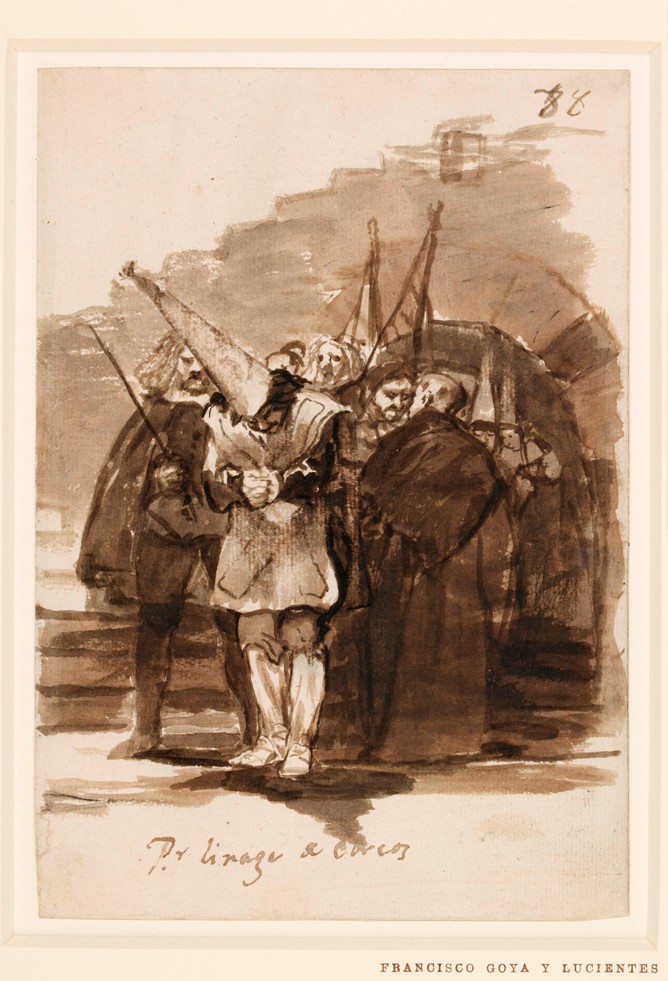Alonso Berruguete, Vicente Carducho, Juan Antonio Conchillos y Falco and Pedro Machuca are hardly familiar names in the Anglophone art world, but their drawings are on view in a revelatory exhibition. The British Museum is showing nearly all its Spanish drawings and a fine, succinct collection of prints, in an anthology called From the Renaissance to Goya.
It makes for a particularly piquant sequel – or rather, prequel - to the high art of that temperamental genius, the Spaniard Picasso, whose Vollard Suite has just been on view. The milestones it encompasses are various. There was the building of the Escorial, monastery and burial place, outside Madrid by Philip II in the 1560s (in which decade Madrid was designated the Spanish capital). Royalty commissioned artists to design triumphs and processions, while the church asked for murals and altarpieces. Seville meanwhile produced not only Velázquez, who made his fortune and achieved his elevated, decorated status as the artist courtier in Madrid, but also Murillo and Zurbarán, and wealthy Valencia commissioned many an artist. Murillo would establish an academy of drawing in Seville in 1660, while the foundation of the Academy of San Fernando in Madrid in 1744 ensured a national standard of academic training. Artists were also imported to energise the native school, among them the Tiepolos, father and two sons.
 Long before tourists began invading the Costa del Sol there was a group of English connoisseurs of Spanish art. Although it was a peculiarly savage way of discovering Spain, the horrors of the Peninsula Wars brought Spanish art to Britain via the Duke of Wellington and others, and of course inspired the Goya to his terrible excoriating images in the magnificent series of prints, The Disasters of War. In the later nineteenth century British private collectors ensured that the British Museum had some hundred or more drawings and, in the twentieth century, thousands of prints.
Long before tourists began invading the Costa del Sol there was a group of English connoisseurs of Spanish art. Although it was a peculiarly savage way of discovering Spain, the horrors of the Peninsula Wars brought Spanish art to Britain via the Duke of Wellington and others, and of course inspired the Goya to his terrible excoriating images in the magnificent series of prints, The Disasters of War. In the later nineteenth century British private collectors ensured that the British Museum had some hundred or more drawings and, in the twentieth century, thousands of prints.
Britain has a handful of outstanding Spanish paintings in its collections, and there have been some eye-opening Spanish exhibitions, but there has never been an overview of works on paper. Indeed, there was a quiet consensus that there was not much worth looking at. So this array of saints, religious tableaux, the gods of myth and some secular portraits makes visible a tradition we did not even know existed.
There is only one Velázquez drawing on view, a spirited sketch of a mounted horse rearing above a riderless horse just turning away, both achieved in just a few scrawled lines brought snorting to life. There is also an elaborate depiction of an auto de fé in 1632 attributed to Velázquez. The Inquisition and the brutality with which heretics were treated is a subtle leitmotif in the exhibition; there is a selection from Goya’s Inquisition album as well as other preparatory sketches (see main image). A powerful and disturbing drawing shows a penitential figure, head bowed in shame, his coming fate presumably horrific, surrounded by a small crowd: the title is For having Jewish Ancestry (pictured above right).
 Goya’s masterly prints after Velázquez shows one artist’s admiration and incisive understanding of another. The exhibition also - perhaps inadvertently - points to Goya’s original imagination and vivid emotion, with perhaps some foreshadowing in the flamboyant inventiveness of the religious scenes conjured up by his predecessors. There are several Murillos, mostly of saints, caught up in an intensity of prayer, and looking thoroughly ecstatic; Jose de Ribera who spent much of his working life in Naples when it was part of the Spanish Habsburg empire shows us poets and martyrs, a drunken Silenus, a Prometheus, and a powerfully rhythmic scene of Christ being beaten by a tormentor. Zurbarán’s Head of a Monk (pictured above left), his skin so taut that the skull is almost visible, is a haunting study that hints at the absorbing power of the contemplative life.
Goya’s masterly prints after Velázquez shows one artist’s admiration and incisive understanding of another. The exhibition also - perhaps inadvertently - points to Goya’s original imagination and vivid emotion, with perhaps some foreshadowing in the flamboyant inventiveness of the religious scenes conjured up by his predecessors. There are several Murillos, mostly of saints, caught up in an intensity of prayer, and looking thoroughly ecstatic; Jose de Ribera who spent much of his working life in Naples when it was part of the Spanish Habsburg empire shows us poets and martyrs, a drunken Silenus, a Prometheus, and a powerfully rhythmic scene of Christ being beaten by a tormentor. Zurbarán’s Head of a Monk (pictured above left), his skin so taut that the skull is almost visible, is a haunting study that hints at the absorbing power of the contemplative life.
But perhaps the most revelatory and touching drawing on view features one of our own: Goya’s red chalk drawing (1812 ) of the hollow-faced wide-eyed Wellington, unnervingly staring out at us. Even the iron duke paid a high emotional cost for the victories of the Peninsular wars: a compelling masterpiece.
Click on gallery images below to enlarge.









![SEX MONEY RACE RELIGION [2016] by Gilbert and George. Installation shot of Gilbert & George 21ST CENTURY PICTURES Hayward Gallery](/sites/default/files/styles/thumbnail_125_x_125_/public/mastimages/Gilbert%20%26%20George_%2021ST%20CENTURY%20PICTURES.%20SEX%20MONEY%20RACE%20RELIGION%20%5B2016%5D.%20Photo_%20Mark%20Blower.%20Courtesy%20of%20the%20Gilbert%20%26%20George%20and%20the%20Hayward%20Gallery._0.jpg?itok=3oW-Y84i)





Add comment